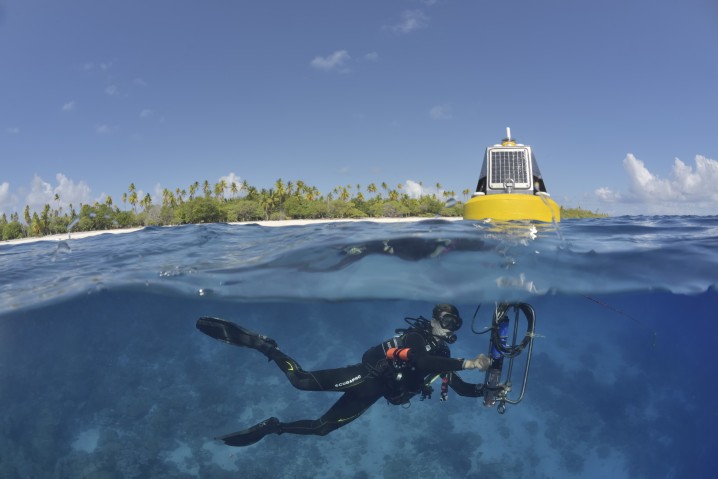MUST SEE: Tairo Atoll – French Polynesia
MUST SEE: Tairo Atoll – French Polynesia –
Tairo Atoll – French Polynesia –
one of THE SEVEN TUAMOTUS IN THIS UNESCO Biosphere Reserve

The Tairo Atoll is part of the UNESCO Tuamotus Biosphere Reserve and was the last of the Tuamotus to be recorded and charted by European explorers. The Biosphere Reserve was established in 1977 and consists of 7 low islands of coral or atoll origin: Aratika, Fakarava, Kauehi, Niau, Raraka, Taiaro, and Toau. These atolls are very different from each other in size, shape, openness to the ocean, population and activities. Its character is unique: there are small closed lagoons such as those of Taiaro and Niau, the former being over-salted while the latter is brackish. And large lagoons open to the ocean such as Fakarava, which has the largest pass in French Polynesia 1,600 metres wide.
The Tairo Atoll is particularly fascinating as it is completely closed off to the ocean. While there may not be any permanent human residents there are many plants, mollusks, and fish. In 2022, a team of adventurous scientists from all over the world led by the Okinawa Institute of Science and Technology ventured to Taiaro to investigate this unique atoll. The interior lagoon is warmer and saltier than the surrounding ocean making it an interesting laboratory for interdisciplinary scientists studying a broad range of subjects form endemic species, to evolution, to adaptation, to climate change and more. For an accessible explanation of this mission, check out the description and video in this article:
https://www.oist.jp/news-center/news/2023/3/10/tiny-atoll-pacific-ocean-offers-glimpse-warmer-world

According to UNESCO, "Biosphere reserves are ‘learning places for sustainable development’. They are sites for testing interdisciplinary approaches to understanding and managing changes and interactions between social and ecological systems, including conflict prevention and management of biodiversity. They are places that provide local solutions to global challenges. Biosphere reserves include terrestrial, marine and coastal ecosystems. Each site promotes solutions reconciling the conservation of biodiversity with its sustainable use. Tairo is one atoll of 7 in the Biosphere Reserve of the Toamotus. It's inclusion is a testament to the unique and phenomenal ecology of the Atoll. Scientists have found a wide range of species inside an atoll that has only seasonal exchange with the outer ocean and hope that the microcosm of Taiaro may present some insight into adaptations to climate change yet to come.

Atolls are evidence of geologic change and great mystery. Once upon a time volcanic islands erupted out of the ocean. Slowly, coral began to encircle and surround the islands. In the Tuamotus the volcanos sunk, collapsed, and/or eroded away into the ocean leaving a ring of coral surrounding lagoons. The Taiaro atoll is a ring-shaped island built up on an ancient volcano that has sunk into the ocean due to the drift of the Pacific Ocean floor. Taiaro is only visible because of the rim of coral that forms a barrier reef 5 km in diameter around the original volcano. The inside of the atoll has a sandy bottom punctuated with coral heads or 'bommies' that host marine flora and fauna. The landmass of the atoll itself is home to endemic birds mollusks, coconut palms and other plants. The biodiversity is impressive.
Nearby, the Tahanea atoll offers a very different experience from Taiaro in that one can enter the atoll and experience the inside and the outside. Perhaps Tahanea offers a glimpse of what Taiaro may be like.


MUST SEE: CIUDAD PERDIDA (LOST CITY) COLUMBIA 🇨🇴
MUST SEE: CIUDAD PERDIDA
(LOST CITY) COLUMBIA 🇨🇴

Ciudad Perdida consists of a series of 169 terraces carved into the mountainside, a net of tiled roads and several small circular plazas.

Hidden deep in the jungle of the Sierra Nevada de Santa Marta mountains in northern Colombia sits an archeological site called Ciudad Perdida, the “Lost City”. Built by the Tairona people in 800AD predating Machu Pichu by over 600 years. The Ciudad Perdida archaeological site only became an attraction after it was uncovered in the 1970s.
Los Sepúlveda was a small family of looters in Colombia; their story leads to the beginning of one of the greatest archaeological discoveries in modern times. The family went hunting in the forests of Colombia when they shot down a wild turkey. Upon retrieving the turkey, they noticed it had fallen on a piece of an exposed staircase. This staircase would lead them to find La Ciudad Perdida. For years after its discovery by the looters, “Treasures from the site, including gold figures and ceramics, soon began to appear on the black market” Archeologists were alerted to these black market treasures and managed to, with the help of indigenous people who protect their ancestral site, trace themselves to the area in 1976. The area was researched and reconstructed over the next 6 years.
Although La Ciudad Perdida is one of the most impressive sites, it’s not alone, only about 30-40% of the sites in the Sierra Nevada region have actually been explored. Thanks to recent widespread access, more and more of these sites are being discovered, and the search for new lost cities has just begun.

Ciudad Perdida was probably the region’s political and manufacturing center on the Buritaca River and may have housed 2,000–8,000 people.
Named Teyuna by the Tairona but dubbed Ciudad Perdida upon rediscovery, the ancient wonder is perched on hillsides and tucked into a dense rainforest.




